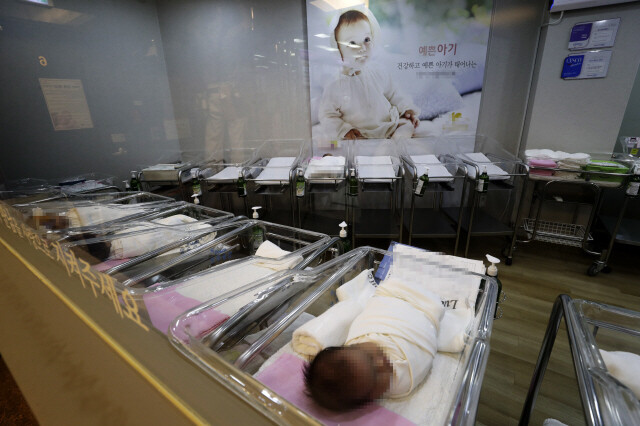300,000 births last year broke
Natural population decline also started for the first time
As if marriage decreases further due to corona
 material photo” alt=”A newborn baby room at an obstetrics and gynecology in Seoul.
material photo” alt=”A newborn baby room at an obstetrics and gynecology in Seoul. A newborn baby room at an obstetrics and gynecology in Seoul. <한겨레> Material photo
Last year, the total fertility rate in Korea fell to 0.84, reaching a record low again. The first natural decline in the population with more deaths than births has also begun. In particular, there are concerns that marriages will decrease significantly due to the corona 19 infection, and the trend of births reduction in the future may accelerate. According to the “preliminary results of 2020 birth and death statistics” released by the National Statistical Office on the 24th, the total fertility rate last year (the average number of births one woman is expected to have a lifetime) was 0.84, down 0.08 from 0.92 in 2019. The total fertility rate fell below 1 for the first time to 0.98 in 2018, and last year also broke the 0.9 level. In particular, the rate of decline in the number of births is accelerating, with the total fertility rate falling to 0.75 in the fourth quarter of last year. There are six regions with a total fertility rate of more than one: Sejong (1.28), Jeonnam (1.15), Gangwon (1.04), Chungnam (1.03), Jeju (1.02), and Gyeongbuk (1.00). Large cities such as Seoul (0.64) and Busan (0.75) had a relatively high proportion of young and unmarried populations, resulting in low fertility rates. Korea’s total fertility rate is the lowest in the world. As of 2018, among the 37 member states of the Organization for Economic Cooperation and Development (OECD), Korea was the only one with 0.98, which was the only zero. The average of the member states is 1.63. The number of births last year was 272,400, down 10% from 2019 (302,700). The annual number of births fell to 300,000 for the first time in 2017, and then fell to 200,000 in just three years. Last year, the number of deaths was 3,05100, which was 32,700 more than births. The first natural decline in the population with fewer births than deaths occurred. Kim Soo-young, head of the Population Trend Division of Statistics Korea, said, “Last year, the number of births has decreased a bit further due to Corona 19, and the number of deaths is expected to continue to increase due to the aging of the population. There will be.” The number of marriages last year was 21,3513, down 10.7% from the previous year. This pattern of population decline is proceeding closer to the’pessimistic scenario’ of the population outlook two years ago by the government. The National Statistical Office predicted the total fertility rate in 2021 at 0.86 in’Special Estimation for Future Population’ in 2019, and predicted that it would be 0.78 if it was pessimistically forecast (low estimate). Last year’s total fertility rate (0.84) is already below expectations this year. Intensifying low birthrates leads to a surge in welfare expenditures such as pensions and medical expenses as an aging population is advanced. On the other hand, economic growth and fiscal income may weaken due to a decrease in the working age population. Two years ago, the government formed a task force for responding to population policy and promised to prepare long-term countermeasures in response to population decline, but it has not produced any clear results. Lee Sam-sik, a professor at Hanyang University, said in last year’s report on’Changes in Korean Population Policy and Implications of the Time’, “It is necessary to fundamentally address not only micro-approaches such as subsidies, but also social culture that takes the sacrifice of family life for granted, and gender inequality labor structure.” Pointed out. In addition, he stressed that the government should move away from traditional marriage and childbirth values and actively accept policies that meet the demands of the young generation, such as unmarried childbirth. By Lee Kyung-mi, staff reporter, [email protected]
